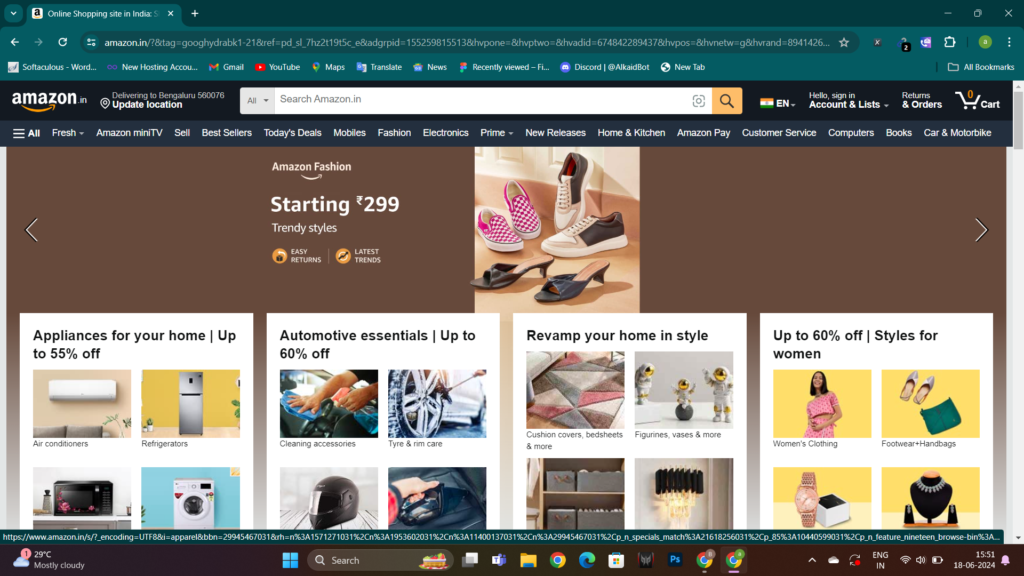Ultimate Guide to Amazon Affiliate Marketing: Tips, Strategies, and Tools for 2024

Introduction
Amazon Affiliate Marketing is one of the most accessible and lucrative ways to monetize your online presence. Whether you’re a blogger, YouTuber, or social media influencer, Amazon’s Affiliate Program offers a straightforward method to earn commissions by promoting products from one of the world’s largest online retailers. This guide will walk you through everything you need to know about Amazon Affiliate Marketing, from getting started to maximizing your earnings with effective strategies and tools.
Amazon, the retail giant, needs no introduction. Its affiliate program, known as Amazon Associates, is among the most popular affiliate programs worldwide, and for good reason. With a vast array of products and a trusted brand name, promoting Amazon products can be both lucrative and relatively straightforward.
What is Amazon Affiliate Marketing?
Amazon Affiliate Marketing, also known as Amazon Associates, is a program that allows you to earn a commission by promoting Amazon products. When someone clicks on your affiliate link and makes a purchase, you earn a percentage of the sale. It’s a win-win situation: Amazon gains customers, and you earn money by driving traffic to their site.
The program is designed to be accessible to anyone with an online presence. Whether you have a blog, a YouTube channel, or a significant following on social media, you can join the Amazon Associates Program and start earning commissions by promoting products. The commission rates vary depending on the product category but generally range from 1% to 10%.

The key benefits of Amazon Affiliate Marketing include:
Wide Range of Products: Amazon offers millions of products, giving you endless options to promote.
Trusted Brand: Amazon is a trusted and well-known brand, which can help increase conversion rates.
Easy to Use: The Amazon Associates dashboard is user-friendly and provides all the tools you need to track your performance and earnings.
How to Get Started with Amazon Affiliate Marketing
1. Sign Up for the Amazon Affiliate Program:
– Go to the Amazon Associates homepage and sign up for an account. You’ll need to provide details about your website or blog and how you plan to drive traffic to Amazon. The sign-up process is straightforward and free.
During the registration process, you’ll be asked for your website details, preferred store ID, and some basic personal information. You’ll also need to outline how you plan to drive traffic to your affiliate links.
2. Choose the Right Niche:
– Select a niche that you’re passionate about and that has a large audience. Popular niches include technology, home improvement, beauty products, fitness, and more.
– A well-chosen niche can make a significant difference in your success as an affiliate marketer. Your niche should align with your interests and expertise, and there should be a sizable audience interested in that niche.
3. Select Products to Promote:
– Choose products that are relevant to your niche and that you believe in. It’s easier to promote products you have used or thoroughly researched. Quality and relevance are key; promoting products that are aligned with your niche and that you genuinely believe in will increase your credibility and trustworthiness.
– Consider the average order value (AOV) and the commission rate when selecting products. Higher-priced items can lead to higher commissions, but they may also be more challenging to sell.
4. Set Up Your Website or Blog:
– If you don’t already have one, create a website or blog where you’ll publish content related to your niche. Platforms like WordPress make it easy to get started.
– Your website or blog is your main platform for publishing content and driving traffic to your affiliate links. Choose a professional-looking theme, and make sure your site is mobile-friendly and easy to navigate.

Effective Strategies for Success
1. Content Creation and SEO:
– Write high-quality, informative content that provides value to your readers. Focus on topics that are relevant to your niche and include your primary and secondary keywords naturally.
– Create different types of content to keep your audience engaged. This can include product reviews, comparison articles, buying guides, how-to articles, and listicles.
– Optimize your content for search engines by using SEO best practices. This includes using proper headings (H1, H2, H3), adding alt text to images, and ensuring your content is mobile-friendly.
2. Drive Traffic to Your Site:
– Use social media platforms to share your content and engage with your audience. Create posts, stories, and videos that link back to your website.
– Utilize email marketing to keep your subscribers informed about new content and special promotions. Building an email list is crucial for long-term success in affiliate marketing.
3. Leverage Social Media and Email Marketing:
– Share your blog posts on social media channels like Facebook, Twitter, Instagram, and Pinterest. Engage with your followers and encourage them to visit your site.
– Use social media ads to reach a broader audience. Platforms like Facebook and Instagram allow you to target specific demographics and interests.
– Build an email list and send regular newsletters with updates, exclusive content, and product recommendations. Email marketing can be a powerful tool for driving traffic and sales.
4. Focus on User Experience:
– Ensure your website is user-friendly, with fast loading times and easy navigation. A positive user experience can lead to higher conversion rates.
– Use clear and compelling calls-to-action (CTAs) to guide your visitors toward making a purchase. CTAs should be prominent and persuasive.
Tools and Resources for Amazon Affiliate Marketers
1. Keyword Research Tools:
– Use tools like Google Keyword Planner, Ahrefs, SEMrush, and Ubersuggest to find keywords with high search volume and low competition.
– Long-tail keywords are particularly valuable for affiliate marketing because they often indicate higher intent to purchase.
2. Content Management Systems (CMS):
– WordPress is a popular CMS that makes it easy to manage your blog and optimize your content for SEO. It offers a wide range of plugins and themes to enhance your site’s functionality and appearance.
– Other CMS options include Joomla and Drupal, but WordPress is generally the most user-friendly and widely supported.
3. Analytics Tools:
– Google Analytics and Google Search Console are essential for tracking your website’s performance and understanding your audience’s behavior.
– Use these tools to monitor your traffic, identify popular content, and track your conversion rates. This data is crucial for refining your strategies and improving your results.
4. Affiliate Marketing Plugins:
– Plugins like ThirstyAffiliates and Pretty Links help you manage and cloak your affiliate links, making them more attractive and easier to track.
– These plugins also offer features like link categorization, automatic keyword linking, and click tracking, which can help you optimize your affiliate marketing efforts.
5. Email Marketing Services:
– Use services like Mailchimp, ConvertKit, or AWeber to build and manage your email list. These platforms offer tools for creating and automating email campaigns, segmenting your audience, and tracking performance.
– Email marketing allows you to maintain a direct line of communication with your audience and promote your affiliate products more effectively.
6. Graphic Design Tools:
– Tools like Canva and Adobe Sparkare useful for creating eye-catching graphics for your blog and social media posts. High-quality visuals can help increase engagement and drive traffic to your site.
– Use these tools to create custom images, infographics, and social media graphics that align with your brand and enhance your content.
Common Mistakes to Avoid
1. Choosing the Wrong Niche:
– Don’t select a niche solely based on its profitability. Choose a niche that you’re passionate about and knowledgeable in. This will make content creation more enjoyable and sustainable.
– Research your niche thoroughly to ensure there is enough demand and that you can compete effectively.
2. Ignoring SEO:
– SEO is crucial for driving organic traffic to your site. Neglecting SEO can result in poor search engine rankings and low traffic.
– Stay updated with the latest SEO best practices and algorithm changes. Regularly audit your site for SEO issues and fix them promptly.
3. Overloading Your Site with Ads:
– Too many ads can make your site look spammy and drive visitors away. Focus on providing value first, and place ads strategically.
– Use ad placements that are non-intrusive and enhance the user experience rather than detract from it.
4. Not Disclosing Affiliate Links:
– Always disclose your affiliate relationships. It’s required by law and helps build trust with your audience.
– Use clear and transparent language to disclose your affiliate links. This can be done in your content, footer, or an affiliate disclosure page.
5. Not Tracking Performance:
– Failing to track your performance means you won’t know what’s working and what’s not. Use analytics tools to monitor your traffic, conversions, and revenue.
– Regularly review your data and make adjustments to your strategies based on your findings.
6. Promoting Too Many Products:
– Focus on quality over quantity. Promoting too many products can dilute your message and confuse your audience. Choose a few high-quality products that align with your niche and promote them effectively.
Conclusion and Next Steps
Amazon Affiliate Marketing offers a great opportunity to monetize your online content and earn passive income. By following the strategies and tips outlined in this guide, you’ll be well on your way to becoming a successful Amazon affiliate. Remember to choose the right niche, create valuable content, optimize for SEO, and use the right tools and resources. Start your journey today by signing up for the Amazon Affiliate Program and begin promoting products you love.
For more tips and strategies, be sure to subscribe to our newsletter and follow us on
social media. Happy affiliate marketing!
Additional Tips for Long-Term Success
1. Build Trust with Your Audience:
– Trust is crucial in affiliate marketing. Be honest and transparent in your reviews and recommendations. Provide genuine value to your audience, and they will be more likely to trust your recommendations and make purchases through your affiliate links.
2. Stay Updated with Industry Trends:
– The affiliate marketing industry is constantly evolving. Stay updated with the latest trends, tools, and best practices to remain competitive. Follow industry blogs, attend webinars, and join affiliate marketing communities to stay informed.
3. Experiment with Different Content Formats:
– Don’t limit yourself to just blog posts. Experiment with different content formats like videos, podcasts, and infographics. Different formats can help you reach a wider audience and keep your content fresh and engaging.
4. Network with Other Affiliate Marketers:
– Networking with other affiliate marketers can provide valuable insights and opportunities for collaboration. Join affiliate marketing forums, and Social media groups, and attend conferences to connect with other marketers.
5. Diversify Your Income Streams:
– While Amazon’s affiliate program is a great starting point, consider diversifying your income streams by joining other affiliate programs and exploring additional monetization methods like sponsored posts, online courses, and digital products.
By following these tips and continually refining your strategies, you can build a successful and sustainable affiliate marketing business. Amazon Affiliate Marketing offers tremendous potential, but like any business venture, it requires dedication, persistence, and a willingness to learn and adapt. Start implementing these strategies today and watch your affiliate marketing efforts pay off.
Case Studies: Success Stories in Amazon Affiliate Marketing
To further illustrate the potential of Amazon Affiliate Marketing, let’s look at a few success stories from real affiliates who have achieved significant success through the program.
1. Pat Flynn – Smart Passive Income:
– Smart Passive Income – Pat Flynn figures in the affiliate marketing industry. Through his blog, Smart Passive Income, he shares valuable content and strategies for building an online business. Pat has been able to generate substantial income through Amazon affiliate marketing by providing in-depth product reviews, tutorials, and recommendations.
2. Michelle Schroeder-Gardner – Making Sense of Cents:
– Making Sense of Cents – Michelle Schroeder-Gardner runs the popular personal finance blog, Making Sense of Cents. She has successfully leveraged Amazon’s affiliate program to earn a significant portion of her income. Michelle focuses on writing detailed and helpful product reviews and incorporating affiliate links naturally into her content.
3. Wirecutter:
– The Wirecutter – Product Reviews website that has built its entire business model around affiliate marketing. Acquired by The New York Times, Wirecutter provides comprehensive and unbiased product reviews and earns revenue through affiliate commissions. Their success demonstrates the power of providing high-quality, trusted reviews to drive affiliate sales.
Frequently Asked Questions (FAQs)
1. How much can I earn with Amazon Affiliate Marketing?
– Earnings from Amazon Affiliate Marketing can vary widely based on factors like your niche, the quality of your content, the amount of traffic you drive to Amazon, and the conversion rates. Some affiliates earn a few hundred dollars a month, while others make six-figure incomes annually.
2. How do I get paid through the Amazon Associates Program?
– Amazon offers several payment methods, including direct deposit, Amazon gift cards, and checks. You can choose your preferred payment method during the sign-up process.
3. Are there any costs associated with joining the Amazon Affiliate Program?
– No, joining the Amazon Associates Program is free. However, there may be costs associated with setting up and maintaining your website or blog.
4. Can I use Amazon affiliate links on social media?
– Yes, you can use Amazon affiliate links on social media platforms. However, it’s important to follow Amazon’s guidelines and disclose your affiliate relationship Clearly.
5. Do I need to have a website to join the Amazon Associates Program?
– While having a website or blog is highly recommended, you can also use other platforms like YouTube, social media, or even an email newsletter to promote Amazon products.
6. What are the Amazon Associates Program Policies?
– Amazon has specific guidelines and policies that affiliates must adhere to. These include rules about how you can use affiliate links, how to disclose your affiliate relationship, and what types of content you can create. Be sure to read and understand these policies to avoid any issues.
Final Thoughts
Amazon Affiliate Marketing is a powerful way to monetize your online presence and earn passive income. By choosing the right niche, creating valuable content, optimizing for SEO, and using the right tools and resources, you can build a successful affiliate marketing business. Remember to stay updated with industry trends, build trust with your audience, and continually refine your strategies for long-term success.
Start your Amazon Affiliate Marketing journey today, and take advantage of the vast opportunities it offers. With dedication, persistence, and the right approach, you can achieve significant success and enjoy the benefits of earning passive income through one of the most trusted and popular affiliate programs in the world.
For more tips, strategies, and updates, be sure to subscribe to our newsletter and follow us on social media. Happy affiliate marketing!

